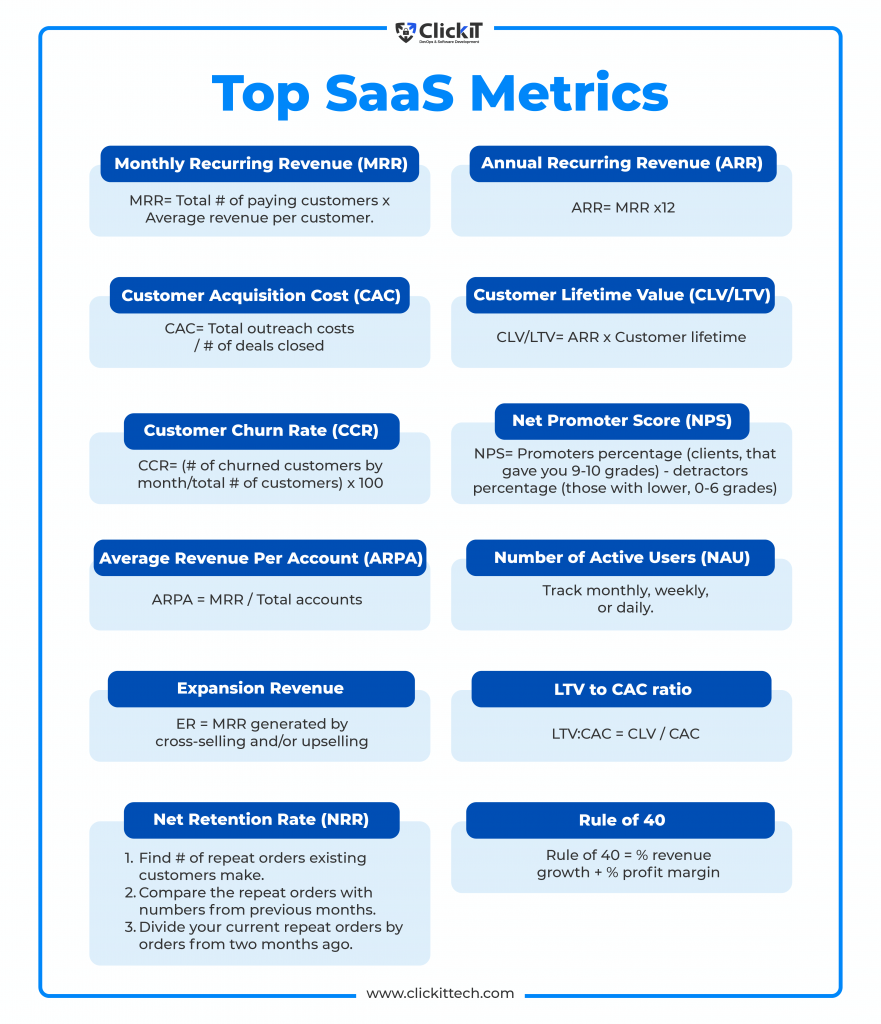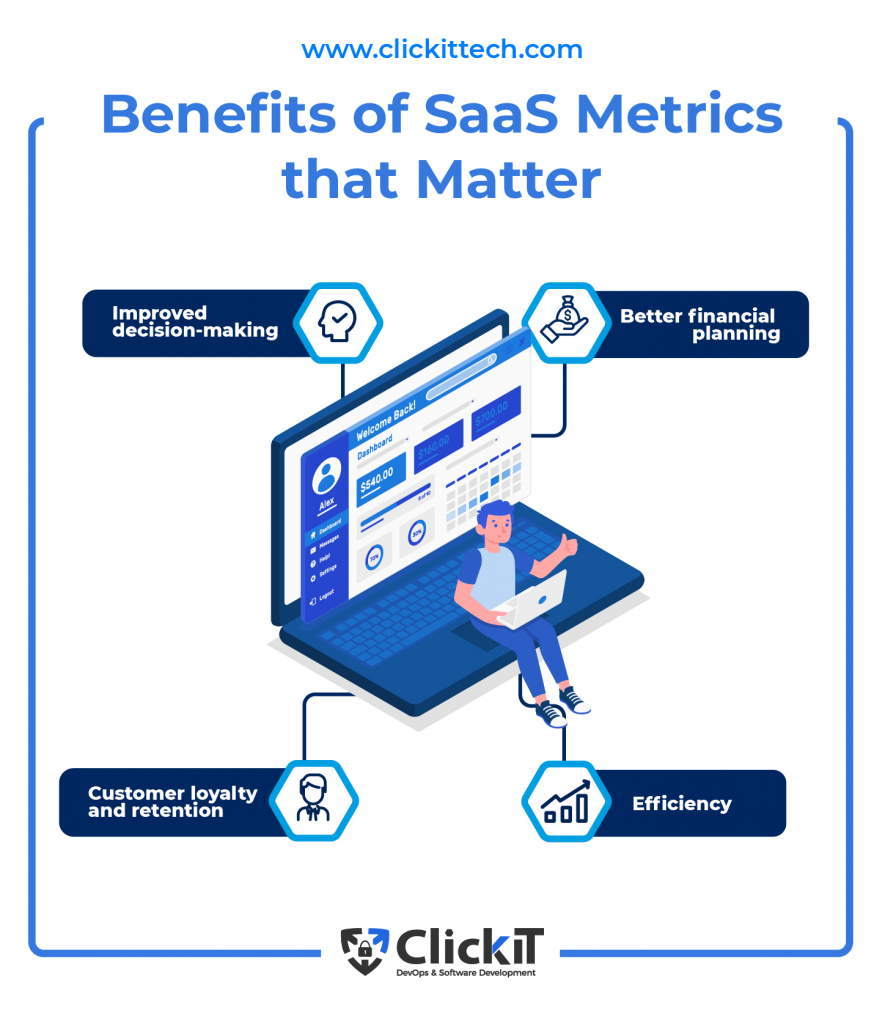Metrics are essential for every business’s success and should never be overlooked. If you can not measure it, you can not improve it! —Lord Kelvin said. SaaS Metrics help businesses stay on track with their SaaS KPIs and improvement plans. Let’s start tracking your company’s key SaaS metrics and why each SaaS metric is important.
Aspects like growth, profitability, and others affect the key SaaS metrics each company considers. This blog will explain the different determinants of SaaS business metrics, its importance, and the benefits it provides. We will also look at the top SaaS metrics that matter for any business and how you can implement them.
- What are SaaS Metrics?
- Most Important SaaS Metrics to Track
- 12 Key SaaS Metrics that Matter
- How to track SaaS Metrics Performance and its Benefits
- ClickIT is an Ally to your SaaS
- Conclusion
- FAQs
What are SaaS Metrics?
SaaS Metrics refer to the performance indicators (KPIs) that measure a Software as a Service business’ success. Some SaaS businesses see them as benchmark brands that track the corporation’s growth and output in the market.
These SaaS Metrics —also known as SaaS KPIs— help to determine a product’s achievements, customer retention, customer satisfaction, and overall health of a business. By taking these key SaaS metrics into account, enterprises can develop a more accurate plan for the future, make the appropriate adjustments whenever needed, and gauge their success.
Most Important SaaS Metrics to Track
These are the 12 most important SaaS Metrics any company must follow:
- Monthly Recurring Revenue (MRR)
- Annual Recurring Revenue (ARR)
- Customer Acquisition Cost (CAC)
- Customer Lifetime Value (CLV/LTV)
- Customer Churn Rate
- Net Promoter Score (NPS)
- Average Revenue Per Account (ARPA)
- Number of Active Users (NAU)
- Net Retention Rate (NRR)
- Expansion Revenue
- LTV to CAC Ratio
- Rule of 40
Ready to implement them on your SaaS? Schedule a call with a team of SaaS Experts!
Before exploring the different SaaS metrics, let’s specify some aspects that can determine which SaaS metrics, analytics, or KPIs you choose.
The key SaaS metrics each company selects to have in its SaaS metrics dashboard can vary depending on its needs and objectives. Their specific business model, platform costs, priorities, and even growth stage can also determine the SaaS metrics and KPIs a company will align to.
Profitability, growth, and cash are fundamental elements for any SaaS enterprise. The first one, profitability, refers to the revenue generated, which will depend on their current subscriptions in the particular case of SaaS businesses.
Growth happens as the brand increases name recognition, and cash refers to the company’s investment. All those aspects are constantly changing; therefore, they alter the key metrics for SaaS organizations as they change.
We have selected some of the most popular and valuable metrics and KPIs for SaaS businesses. They all measure specific data that can contribute to your enterprise’s success and long-term stability. Let’s review them.

12 Key SaaS Metrics that Matter
1. Monthly Recurring Revenue (MRR)
Considered one of the most critical SaaS business metrics, the MRR represents the total monthly revenue generated by a subscription-based service. Its understanding allows you to predict incoming revenue and create a baseline.
A company’s monthly recurring revenue should be the center of its business model. If they plan to scale profitability, they need to know how much they make and the amount of money it costs to turn a potential lead into a customer.
Here’s a formula you can follow to calculate your MRR.
MRR = Paying customers x AR per customer
*The total number of paying customers is x the average revenue per customer.
Why this SaaS Metric is important?
MRR measures the predictable revenue generated from subscriptions on a monthly basis. It provides insight into the company’s revenue stream and its growth trajectory.
2. Annual Recurring Revenue (ARR)
The ARR reflects the company’s capacity to grow and retain its customer base.
It is basically the same as MMR viewed on an annual basis. ARR represents the total revenue a business can expect to receive in a year.
Such data can be beneficial for budgeting future expenses; while you track your progress, you can also forecast succeeding developments.
An enterprise’s ARR results from multiplying the number of customers by the average revenue per customer (ARPC). You can also multiply your MRR by 12.
ARR = MRR x 12
Why this SaaS Metric is important?
ARR is the predictable revenue generated from subscriptions on an annual basis. It provides a broader view of revenue stability and growth over a longer period compared to MRR.
3. Customer Acquisition Cost (CAC)
Have you wondered about the cost it takes to acquire a new customer? That’s (in easy words) what the CAC is all about.
CAC means the total amount spent on sales, customer service activities, and marketing to gain a new client. While CAC can vary according to market industry or even product pricing model, it can greatly benefit the monitoring of customer acquisition efforts.
SaaS businesses must discover cost-effective ways they can earn new customers. With them, they can track their customers’ average lifetime value and make marketing efforts around the data.
CAC = Total outreach costs/ closed deals
*Total outreach costs (Sales, marketing, etc.) / Number of deals closed
Why this SaaS Metric is important?
CAC measures the cost associated with acquiring a new customer. Understanding CAC helps in determining the effectiveness of marketing and sales efforts and ensuring that the cost of acquiring customers doesn’t outweigh the revenue they bring in.
Other software development companies can also benefit from implementing KPI metrics. Check out our article Top 10 Software Development KPIs Your Team Needs.
4. Customer Lifetime Value (CLV/LTV)
One of the key SaaS metrics or analytics businesses should consider is the CLV. The Customer Lifetime Value calculates the total expected revenue a client will generate for a company.
Determining your organization’s benefit derived from a long-term customer partnership gives you a far-reaching perspective on strategies for customer engagement. The longer the relationship, the higher the lifetime value.
A simple formula to calculate the LTV consists of multiplying the average annual revenue by the average customer’s lifespan.
CLV/LTV = ARR x Customer lifetime
Why this SaaS Metric is important?
CLV/LTV represents the total revenue a business can expect from a single customer over their entire relationship with the company. It helps in evaluating the long-term profitability of acquiring and retaining customers.
5. Customer Churn
The customer churn rate measures the percentage of a company’s customer base that cancels or discontinues its subscription in a given period. In short, it presents the results of customer retention efforts and is usually measured monthly.
Churn can result from poor product innovation, poor customer service, customers receiving a more attractive offer, etc. Staying aware of your churn rate is essential, as it reveals patterns that could be damaging client satisfaction.
Customer churn rate = (#CCM/#C) x 100
*(Number of churned customers by month / total number of customers)
Why this SaaS Metric is important?
Churn rate measures the percentage of customers who cancel their subscription within a given period. It’s crucial for understanding customer satisfaction, identifying potential issues with the product or service, and assessing overall business health.
6. Net Promoter Score (NPS)
One of the easiest ways to learn about customer satisfaction is through NPS.
The Net Promoter Score measures clients’ loyalty and satisfaction and identifies areas for improvement.
These SaaS analytics rate the likelihood of having customers recommend your product and is normally based on an NPS survey. You can find it in companies website as a pop-up asking, “How likely are you to recommend ClickIT (or the specific product/service the company offers)?”
NPS = PP – DP
*PP: Promoters Percentage (clients that gave you 9-10 grades)
*DP: Detractors Percentage (those with lower, 0-6 grades)
Why this SaaS Metric is important?
NPS measures customer loyalty and satisfaction by asking customers how likely they are to recommend the product or service to others. It provides insights into customer sentiment and helps in identifying areas for improvement.

7. Average Revenue Per Account (ARPA)
Another vital measure between the SaaS key metrics is the Average Revenue per Account, essential for tracking the pricing’s appropriateness.
The ARPA measures the average revenue generated by each customer account. It’s a good idea to include it in your SaaS metrics dashboard analytics, as it enhances the understanding of sales and marketing strategies’ effectiveness.
Calculate it by dividing your MRR (monthly recurring revenue) by your total accounts.
ARPA= MRR / Total accounts
Why this SaaS Metric is important?
ARPA measures the average revenue generated per customer account. It helps in understanding the revenue contribution of each customer and identifying opportunities for upselling or cross-selling.
8. Number of Active Users (NAU)
Understanding these SaaS KPIs shouldn’t be a problem. Above all, it refers to the number of people actively using it in a specific period.
The number of active users reflects a SaaS business’s health and its customer base’s well-being. NAU can be useful when tracking engagement levels, user base growth, and client retention. It can also help you understand your power users’ behavior.
You can calculate it considering different tracking periods: monthly, weekly, or daily.
Why this SaaS Metric is important?
NAU indicates the number of users actively engaging with the product or service within a given period. It helps in assessing product adoption, usage patterns, and overall customer engagement.
9. Customer Retention Rate (CRR)
The customer retention rate is of the most relevant SaaS analytics to keep on your dashboard. In fact, CRR measures the percentage of active customers who continue to use the service over a specific period.
All enterprises aim to deliver services that develop affinity among their clients so that they keep on using them. A high CRR indicates that customers are satisfied, engaged, and remain loyal to the product. It also means you can focus on preserving existing users instead of attracting new ones.
The first step to calculating your CRR consists in finding the number of repeat orders existing customers make. Then, you can compare the repeat orders with numbers from previous months (two months). At last, you divide your current repeat orders by orders from two months ago, and you’ll have your retention rate.
Why this SaaS Metric is important?
CRR measures the revenue retained from existing customers after accounting for churn, upgrades, and downgrades. It reflects the company’s ability to retain and grow its existing customer base.
10. Expansion Revenue
When a company generates more revenue from existing customers, expansion revenue occurs. This can result from the platform upselling new services, providing additional features, or increasing the subscription frequency.
Expansion revenue is a great way to combat churn, increasing a company’s monthly recurring revenue.
ER = cross-selling/upselling.
*MRR generated by cross-selling and/or upselling.
Why this SaaS Metric is important?
Expansion revenue represents the additional revenue generated from existing customers through upsells, cross-sells, or upgrades. It contributes to overall revenue growth and reflects the company’s ability to monetize its customer base effectively.
11. LTV to CAC Ratio
The LTV: CAC ratio compares customer acquisition and customer lifetime value. Therefore, it measures the return on investment (ROI) for customer acquisition.
Comparing your acquisition costs and lifetime value lays out insight regarding the success of your marketing efforts leading (or not) to sustainable growth. A high LTV: CAC indicates high ROI for customer acquisition. Accordingly, such positive SaaS metrics can be an important indicator of a successful SaaS business in the long term.
A recommended LTC: CAC ratio is 3:1. Your efforts to maintain a customer should only represent around a third part of the revenue you make from it. For example, if you make $1,000 on a customer, $300 would be a reasonable amount to spend on maintaining them.
As with other key SaaS metrics, your sights can be even higher if you are determined to achieve more growth.
LTV : CAC
*Customer Lifetime Value / Customer Acquisition Cost
Why this SaaS Metric is important?
This ratio compares the lifetime value of a customer to the cost of acquiring that customer. A ratio greater than 1 indicates that the customer’s lifetime value exceeds the cost of acquisition, indicating a healthy business model.
12. Rule of 40
The rule of 40 measures the overall financial performance of a SaaS business. The idea is that a SaaS company’s combined profit margin and growth rate should exceed or equal 40%. Organizations above 40% generate profit at a sustainable rate that could lead to financial success.
Investors consider the rule of 40 when evaluating SaaS businesses’ financial health. This is due to the quick overview of a company’s performance the rule of 40 provides.
Furthermore, to calculate this metric for SaaS businesses, you simply add your revenue growth in percentage terms plus your profit margin percentage.
Why this SaaS Metric is important?
The Rule of 40 states that the sum of a company’s growth rate and profit margin should be at least 40%. It helps in balancing growth and profitability and is used as a benchmark for evaluating SaaS companies.
How to track SaaS Metrics Performance and its Benefits
SaaS Metrics Dashboard
The competitiveness of the SaaS market requires businesses to keep up with their performance by tracking the SaaS analytics that benefit them the most. Nevertheless, the data resulting from such tracking actions can rapidly build up and cause confusion or disorientation. That’s precisely why you need a SaaS metrics dashboard.
The main mission of a SaaS metrics dashboard is to measure the performance of a Software as a Service application. With it, you receive a visual overview of your key SaaS analytics, such as customer lifetime value, annual recurring revenue, customer churn, etc.
When you build a cohesive and understandable SaaS metrics dashboard, you can identify areas that need improvement and track products’ success. It is also useful for measuring the effectiveness of your implemented strategies.
A SaaS metrics dashboard makes data-driven trends easier to spot by offering a user-friendly data layout. Hence, informed decisions that lead to a profitable and prosperous future are more simple to make.
SaaS metrics dashboards can be as specific or as general as you need them to be. For instance, if you want a SaaS metrics dashboard focused on management, you could include SaaS analytics like MRR, CAC, CRR, Customer churn, and more.
You can create your own SaaS metrics dashboard from scratch and craft it in the most beneficial way for your business. Nonetheless, companies like datapine specialize in creating dashboards that help visualize the insights SaaS metrics (and general KPIs) provide.
They also supply dashboard examples that can give you an idea of where and how to begin building your own.
Benefits of SaaS KPIs
Are you convinced about the urgency of monitoring your business’ SaaS Metrics now?
One of the most important saas metrics include improved decision-making and better financial planning. Customer loyalty and efficiency can experience enhancement too.
Improved decision-making
When SaaS businesses track their metrics or KPIs, they are able to identify trends and patterns that lead to clearer, better-informed decisions.
With key SaaS metrics like customer lifetime value and retention rates, organizations can better understand customer preferences and needs. They should take these as opportunities for enhancing and shaping an action plan capable of achieving their goals.
Data-driven decisions lead to better outcomes.
Better financial planning
Information supplied by metrics for SaaS businesses nurtures future financial needs forecasts and can help create accurate budgets; that’s why being aware of the key SaaS Metrics is a must when creating and maintaining a SaaS.
By tracking SaaS metrics, enterprises have a superior understanding of their financial and overall organizational health. Comprehension of such KPIs is essential for properly allocating resources and ensuring their strategies align with the company’s objectives.
Looking to start your own SaaS business? Read our blog about SaaS Business Models to choose the one that fits you the most
Customer loyalty and retention
As mentioned, SaaS business metrics let firms craft strategies and products suited to their customers. Giving clients exactly what they want upgrades their experience, building trust and loyalty with the brand.
Furthermore, keeping an eye on SaaS metrics or KPIs regarding client usage lets companies identify customers with the highest engagement rates. Loyalty programs and special incentives can then target those “top customers,” giving the feeling of mutual care and recognition.
Efficiency
Properly applying SaaS KPIs allows enterprises to acknowledge how customers use their products and services. Using usage data, enterprises identify their most popular features and those that need improvement.
Instead of guessing which changes will suit customers (and therefore products) better, corporations target their efforts and work on the modifications that will give them greater results.
By the way, focused actions also save tons of money that otherwise would be spent on trial and error.Take the right step forward and build a SaaS Application with ClickIT

ClickIT is an Ally to your SaaS
As you can see, managing a SaaS business requires considerable time and effort. While most aspects we have discussed so far are related to an administrative and management level, the development side of SaaS must receive just as much attention.
SaaS Application: The Future of Businesses
ClickIT is a nearshore DevOps and software development company that delivers SaaS, startups, and enterprise companies with holistic, cutting-edge solutions. With us, IT companies can build cloud applications that cover their needs and provide the best possible experience to their clients.
When you have a trustworthy, dedicated team like ClickIT to manage your software products, you can focus entirely on aligning your metrics and strategies with your requirements. Make the most of this opportunity and take your SaaS analytics to the next level; check us out!
Conclusion
Measuring, monitoring, and understanding SaaS metrics is a foundational step toward the triumph of your company. Likewise, building on the words of Lord Kelvin, metrics lay out all the data you need to know to keep your business in its optimal stage.
You can view them as your yearly medical health studies; you can only purposefully improve those aspects you know are not in their best shape. Metrics also give information about what’s correct and from which you can feel proud of.
Remember: SaaS metrics (or analytics) are here to help us. They are tools that make our jobs easier and superior. We must use them accordingly and apply them to deliver the finest services in the market.

FAQs
SaaS Metrics are performance indicators that measure a software as a service business’ success.
The most important analytics or KPIs for each SaaS company will vary depending on its needs, objectives, and growth stages. However, some of the most popular include Monthly recurring revenue (MRR) and Customer acquisition cost (CAC). Tracking Customer lifetime value (CLV), Customer churn rate, and Number of active users (NAU) can also be beneficial.
The rule of 40 measures the overall financial performance of a SaaS business. It states that a company’s combined profit margin and growth rate should equal or exceed 40%.
The customer lifetime value calculates the total expected revenue a client will generate for a company. In fact, it is considered a goal standard SaaS metric.
A Key Performance Indicator (KPI) refers to a quantifiable metric used to measure the success and performance of a SaaS business. These metrics provide insights into crucial aspects such as user engagement, customer retention, revenue growth, and operational efficiency.








